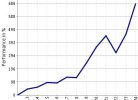By MITCH ZACKS
Despite some market volatility experienced over the past week, U.S. stocks – as measured by the S&P 500 – are hovering around all-time highs. As I write, the S&P 500 is up over 5% to start the year, and the index has recorded 10 all-time highs so far in 2024.
That makes investors worried.
It’s understandable why investors would get jittery here. Stocks’ powerful rally, going on four months now, gives the impression that share prices are getting too frothy—especially considering that interest rates are still high, inflation is still above target, many Americans don’t feel great about the economy, and the geopolitical outlook is one of uncertainty and instability. And yet stocks are surging?
There’s another point to make, which I think influences investor sentiment, sometimes indirectly. And that is: bear markets and/or market crashes almost always start with ‘all-time highs.’
This setup can sometimes lead to two responses: 1) investors get out of stocks because of the ‘fear of heights’; or, 2) investors attempt to time the market top, often with the strategy to “buy the dip” later. I would strongly urge against both approaches.
The first reason, in my view, is that the predominant factor driving the sustained rally is better-than-expected economic and earnings growth, especially what we saw in Q4 2023 and in January data. With 67% of S&P 500 companies reporting Q4 earnings as of February 9, the blended earnings growth rate was 2.9%, with 75% of companies surprising to the upside. Positive earnings and upside surprises are happening despite the ongoing drag from the Energy and Materials sectors, and the stock market’s enthusiastic response mirrors what we saw in 2023.
The second reason is that historically, all-time highs tend to be followed by more all-time highs. And certainly, more new highs than we’ve seen so far in 2024.
During the 1990s, the S&P 500 recorded a new all-time high on 12% of all trading days. More recently, there have been two bear markets since 2020, and yet the stock market still reached a new all-time high on 11% of all trading days. It happens more often than many investors appreciate.
There’s also some data on one-, three-, and five-year returns following all-time highs that may surprise readers. A recent study compared one-, three-, and five-year S&P 500 returns when an investor bought the index on any day, versus buying at all-time highs. Here are the findings:
- Invest in the S&P 500 on any day between 1988 and August 2020, and your average cumulative forward returns would have been:
- 1-year: +11.7%
- 3-year: +39.1%
- 5-year: +71.4%
- Invest in the S&P 500 on days when the index reaches an all-time high, also between 1988 and August 2020, and your average cumulative forward returns would have been:
- 1-year: +14.6%
- 3-year: +50.4%
- 5-year: +78.9%
The data may be surprising but it’s also clear – average forward returns were better when an investor bought the S&P 500 at an all-time high. There’s a reason the data looks this way. It’s because bull markets generally do not reach all-time highs and then abruptly end. By definition, they continue to reach new all-time highs as a reflection of growth trendlines we see in the economy and within corporate earnings. There are exceptions when a bull market only achieves a handful of new all-time highs, like in 2007, but these are fairly rare.
Bottom Line for Investors
My long-term goal is to capture as much upside as the broad equity markets have to offer, and the most effective way to accomplish this goal is to invest alongside growing earnings and an expanding economy. In 2024, I believe we will get both – economic growth has outpaced expectations on the back of strong consumers and a strong labor market, and Zacks is forecasting a sturdy year for earnings growth, likely over 10% for the full year, in our view.
In the current environment, I can see how all-time highs might seem like a warning signal, particularly with growing optimism and high valuations in some key areas. But I would caution against seeing all-time highs as a rationale for trying to time a market top. After all, the stock market could very well rally +30% before experiencing a meaningful correction, deeming the strategy ineffective.
If you want to capture the economic and earnings growth 2024 is poised to deliver, then my advice would be to own stocks – not to buy and sell them based on predictions about market tops and potential corrections.
Wenn du keinen Beitrag mehr verpassen willst, dann bestell doch einfach den Newsletter! So wirst du jedes Mal informiert, wenn ein neuer Beitrag erscheint!
±







